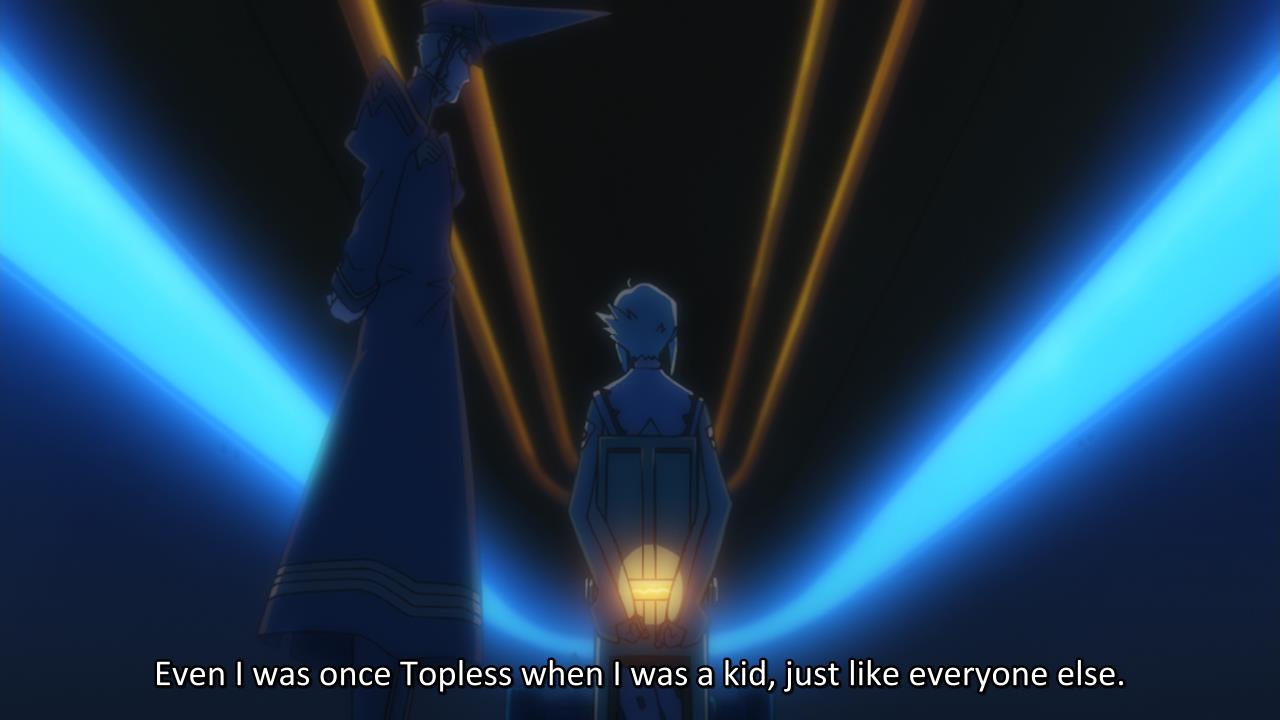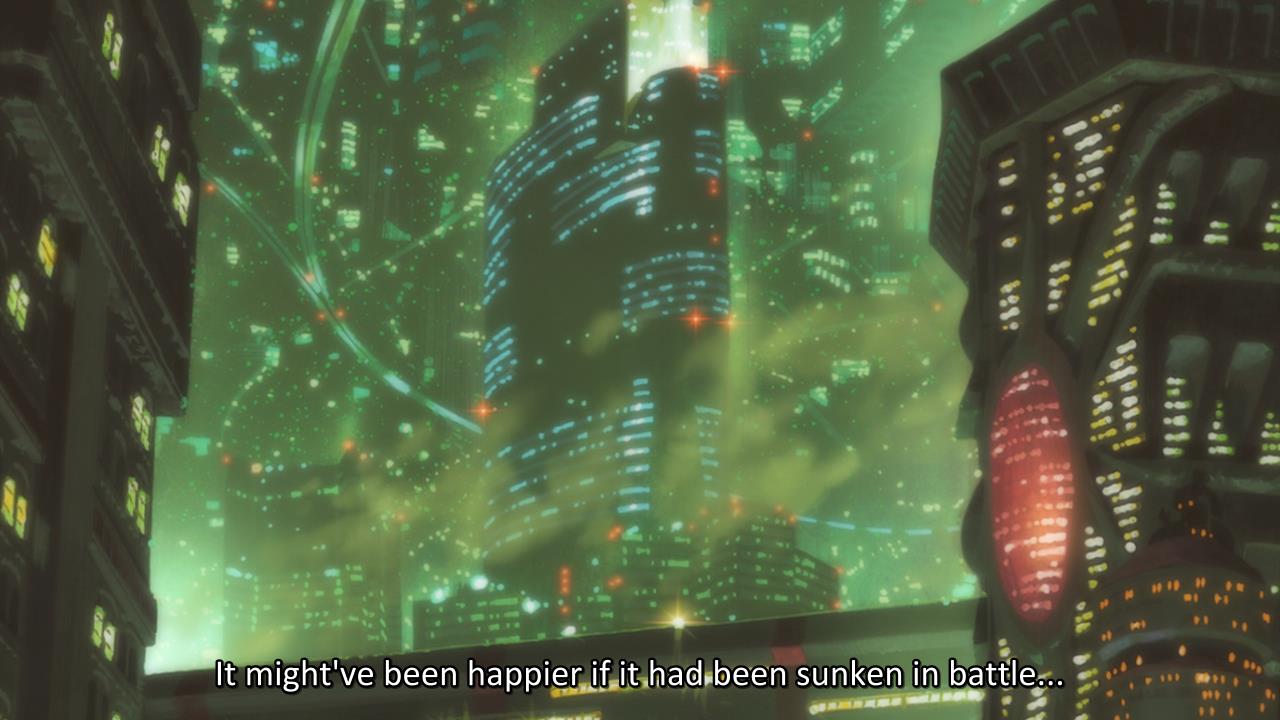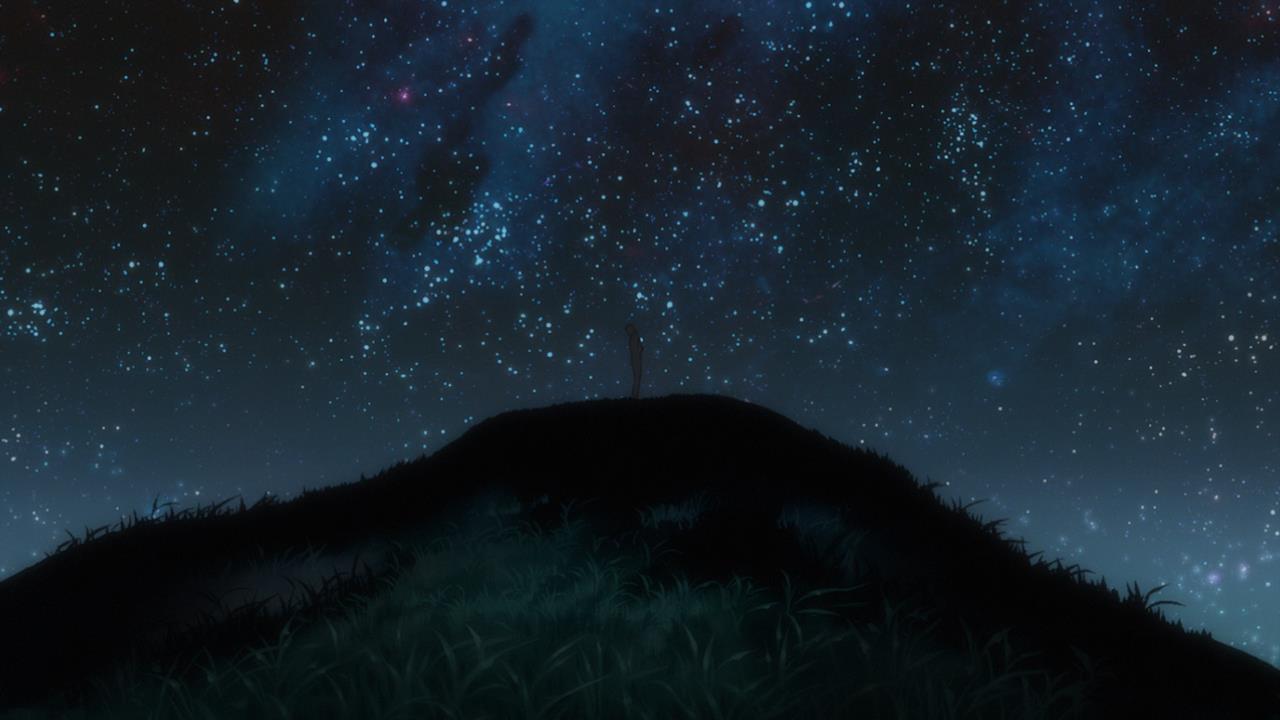“Like a trash can fire in a prison cell,
Like the search lights in the parking lots of hell.
I will walk down to the end with you
If you will come all the way down with me.”
– The Mountain Goats, Old College Try
Set eleven thousand, nine hundred and ninety years after Gunbuster, Diebuster tells the story of a new hero – Lal’C Mellk Mal, who befriends the chipper robot Nono. Unlike Noriko, Lal’C begins our story a hero – not just one of the rare Topless, adolescents who pilot Buster Machines to defend the human race, she is the “curve breaker,” envy of her peers. A bright star, casting a light for all of humanity. And she’s proud of this – though she feigns indifference, in truth she exults in her position, cherishing the adulation she receives. Lal’C Mellk Mal exemplifies the power of youth, and in Diebuster, youth is not simply something to be coveted – it is a tangible power in this world.
The Buster Machines are the vehicle for youth, massive robots that can only be fueled by those young enough to still manifest their Topless abilities. Through their channeling, the impossibility of childish potential is made real. Their powers are absurd – they defy reality, defy perspective. Adults cannot see beyond the world as it exists – they know too much, and ask too many difficult questions. But children? They can dream the impossible, and believe in things any adult mind would dismiss, in spite of any and all tangible evidence to the contrary. And their hopes all the more fervent for the knowledge that dreams will someday end.
In the world of Diebuster, where adulthood may as well mean death, the power of youth is something worth clinging to. Everything in Lal’C’s world confirms this separation, this fear – though she lives in a world of grandeur and play, there is always the specter of adulthood, waiting, looking in. The adults speak of nostalgia, and talk enviously of the powers they can’t recapture. The very world they inhabit sags with exhaustion, built on the ruins of dead ancestors. If FLCL represents the youthful edge of adolescence, Diebuster represents its end – it knows we can only seize life for so long, and it fears what lies on the other side. Fears aging, fears uselessness. Fears death, but also idolizes it – because if a life of decay is worth nothing, a beautiful death may be our only solace.
As with Gunbuster, death’s specter hangs over the heroes of Diebuster. Not just the loss of others this time – Diebuster’s heroes are both older and perhaps more selfish, and the fear of their own obsolescence hangs heavy in their minds. With her identity so contingent on the praise her Topless abilities win her, Lal’C sees death as an inevitability, something to be engaged with before time’s arrow steals her youthful glory. To live forever is the ultimate punishment – no other fate could be so cruel. Lal’C’s initial wish is to die well – die proudly, as a falling star. Die with her friend beside her. But Nono changes her.
Caught in the maelstrom of their final battle, with her Topless abilities and external pride run dry, Lal’C ultimately admits she has come to terms with aging. She could stomach the burnout, stomach the decay – as long as Nono were there beside her. Laid bare in the honesty of her friend’s hands, she admits it’s not the glory she needed – that any of us need. It’s the feeling of worth, of connection. It’s to not die alone. And as Nono sacrifices herself to save humanity and her friend, Lal’C is abandoned – left in the cold grip of time, the former hero fades to one more fallen star.
But as with Gunbuster, the truth is, we are never alone. We cling to imperfect connection, but the beauty of our fractured, short-lived, individual nature is that we are not robots, doomed to float in oblivion. We are bright stars, who burn out and die young, but who even in our aging contribute to a grand network of life. The great works of our ancestors are not grave markers, but contributions to our eternal living document. And though nostalgia and decay are inevitable, they do not make life any less beautiful or worth clinging to. Becoming an adult isn’t easy – purpose isn’t given to you, and accepting your own life’s passing with grace requires embracing the unselfish humanism that Nono’s sacrifice represents. But as Lal’C awaits the return of the girl who inspired her friend, we see in her smile the greater spirit of humanity that bathes us in brilliant light. Our triumphs are necessary because they offer a hand to the next generation, and the sky is full of falling stars. We are never alone.




I remembered when I first watched it I had a problem with Nono ending up dying. When I watched it again older her sacrifice felt much more poignant and almost necessary. It reminded of a quote from a source I forgot: “…because human lives are so short, it makes living them so much more colorful.”.
I feel her sacrifice basically makes her human – her willingness to give of herself so that others may live is tied again and again in these shows to “the instincts of the human animal.” And that quote sums up a lot of what these shows are saying, too!
Couldn’t read the Rebuild essay because I haven’t seen 3.33, and couldn’t read Utena because, well, I haven’t seen Utena. But I have recently seen Diebuster!
The ending of Diebuster is probably one of my favorite endings ever. Elevated the show quite highly in my eyes, and I’d be lying to myself if I said there weren’t any tears in my eyes. The realization of what was happening, combined with the intensity of the final episode was just amazing. Aging and just acceptance of life is one of my favorite themes, and I think Diebuster captured it perfectly. I think I like Diebuster as a whole a little more than Gunbuster, but that may just be because Die reminds me FLCL, which I adore. Beautiful little show.
Yeah, I really, really love Diebuster’s perspective on aging. The degree to which it actually acknowledges and even embraces how terrifying the thought of growing old can be… I wish more anime were so committed to treating this subject with actual respect. And yes, that ending is gorgeous.
And this, plus the other meaning of the Diebuster ending – tying a perfect knot to the circle of “Buster” from Gunbuster – is why I actually prefer Diebuster over Gunbuster, though both are perfect equals in strength and themes. A fantastic post as usual, keep it up!
Diebuster speaks to me a bit more too, maybe just because I can so strongly relate to its anxieties. Glad you liked the post!
I think the moment when Diebuster really clicked for me was when Casio follows Nono in an attempt to pilot a real Buster Machine, only to find that the thing he’s looking for–his last chance at grasping youth and the power that comes with it–is nothing more than a desiccated corpse. It’s very Utena, in a way, where the Prince was always the Lord of the Flies, his kingdom illusory. What Nono realizes in that moment is that the power of the Topless isn’t quantifiable, it’s a state of mind. The Topless fight with each other like the teenagers they are, Casio longs for something he can never have, but in the end none of that really matters. What DOES matter is being determined, having an open mind no matter what, confronting an impossible situation with all the hard work and guts you can muster. In a sense Nono being Buster Machine #7 is a direct response to years of mecha anime in which the giant robot is the be-all-end-all. Who needs a Buster Machine when you have a Buster Machine in your heart? Nono realizes this and in doing so transcends the limitations of her universe and becomes all-powerful.
I think what threw me in the last two episodes of Diebuster is how Nono fails initially, running away from the enemy rather than defeating it. If Nonon becomes an adult in episode 4, why does she make the same mistake as all the other Topless and try to beat the enemy with a bigger robot? The conclusion I came to (and hopefully I’ll be able to write this up on SBD at some point) is that Nono can’t do this alone. As a Buster Machine she’s so bound to the source that when push REALLY comes to shove she can’t see outside the box. It’s only when Nono (perpetually immortal, all-powerful, but unable to fully understand death and aging) and Lal’C (Noriko’s true heir, human and vulnerable but willing to put everything she has on the line no matter what) come together, witch/prince and prince/witch, that they are able to “revolutionize the world,” so to speak. I wouldn’t say that Diebuster is a perfect show by any stretch of the imagination (both FLCL and Utena do it one better) but I do love how it seems to tie together all the conflicts and themes present in Enokido’s work and serves as not only a spiritual sequel to them all but also a post-modern middle finger to the whole idea of giant robots and what they’re supposed to signify. I think Gunbuster has it beat in terms of sheer emotional kick, but there’s something to be said about a show that pulls the carpet out from under you from the very first episode (MARS!) Man, I really hope that Captain Earth comes close to what these guys did (though Enokido and Igarashi haven’t worked on anything legitimately great in a while…)
By the way, thought I should link you to the article that introduced me to Diebuster and made me really want to watch the damn thing: http://superfani.com/2009/06/04/of-diebuster-structure-and-the-parents-of-gods/
I’ll probably have to watch the damn thing again to gather my thoughts on Nono herself – her statements from episode four felt out of step with the rest of the show’s messages as I read them, though as you say, ultimately she does need to cooperate with a friend to achieve victory. It’s never the powerful characters that interest me – like Nanami in Utena, it’s the fragile humans who don’t have the luxury of stardom who strike me as most joyously human, and the end of Diebuster feels like a paean to our collective vulnerability. Which also doesn’t really correlate with the linked article’s focus on mythbuilding and modern godhood, but I guess good shows aren’t required to spell out all their secrets.
I just finished Diebuster. You’ve articulated the main themes (of fear of losing one’s youth etc) well here. I quite liked the show myself and felt it did a great job of feeling like a space-opera FLCL. Unfortunately it did a stupendously bad job of feeling anything at all like Gunbuster, which hurt my enjoyment of the ending a little because I couldn’t quite suspend my disbelief that both these stories are taking place in the same universe. The general tones and seriousness-levels are just too different.
I also liked how they trusted the audience to understand the setting and plot without infodumping, but the reliance on quick flashbacks for character development felt a bit scatterbrained, and the climax was totally incoherent – a parody of End of Eva for the 20th anniversary theme I guess. I also really liked Nono – Casio said something like “it’s relaxing to be around you” and I’d agree.
Maybe it’s because I separated them with Utena, but I actually didn’t feel that much of a disconnect between the two – they felt like variations on a theme, with the “variations” just being the very different aesthetics of Gainax circa late 80s and Gainax circa early 00s. And I actually thought Diebuster handled its characters and themes in a more thoughtful way than Gunbuster – it rang more true to me than stuff like the Coach romance in the first one.
I rewatched Gunbuster right before, so the contrast probably stood out more to me. Basically, Gunbuster felt like a comedic (at first) presentation of an underlying serious story, whereas Diebuster was the opposite – a serious take on a fundamentally silly premise.
I do agree that Diebuster was more subtle and in-depth in its characterization compared to Gunbuster’s comic theatricality. I did think though that all those little intra-story flashbacks were trying a bit too hard – those scenes would have worked just as well straight-up and with less unnecessary complexity.
Pingback: Top 30 Anime of All Time | Wrong Every Time
Pingback: Top 30 Anime Series of All Time | Wrong Every Time
A pretty late reply, but I really liked both your article and the show. I actually agree with you, about Diebuster handling its characters better than Gunbuster. While I’m sure many fans would disagree with me, I found Nono’s character and development to be more interesting than Noriko’s. Seeing Nono constantly following Lal’C around in the first few episodes, trying to impress her and earn her attention, and struggling despite being ostracized by the rest of the Topless felt very believable and relatable to me. In comparison, the confrontation between Noriko and the bully in episode 1 of Gunbuster felt rather over the top, with the bully being ridiculously ‘evil’ and aggressive. It just didn’t click with me as much as Diebuster did.
Also, Nono’s realization in episode 4 of Diebuster, about inner strength being more important than possessing a Buster machine, is probably my favourite moment in the series.
After pondering what you said about the human animal defending its future generations being a central theme in Gunbuster, I’ve realized that so much of that idea is captured in Nono and how she behaves in Diebuster. She feels, more than anything, like a sort of overinvolved parent to Lal’c and the other characters throughout the show’s run. On multiple occasions she’s there to either guide the other pilots toward the right direction (episode 2 with Lal’c and 3 with Tycho) or outright saving them from imminent peril (episode 4). The conflict between Diebuster Nono and Lal’c leading up to the finale of the final episode is Lal’c refusing to let Nono, and effectively the older generation of Gunbuster as a whole, continue being the protective parent constantly insuring the safety of the future generation and instead demanding that the new generation be finally allowed to fend for itself.